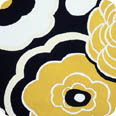
This is my first attempt at a Stack the Deck quilt. It's a simple design, which I saw in a quilting magazine. I found some fun fabric (Lingerie on the Line by Alexander Henry) and combined it with several colors of coordinating cotton jacquard by Robert Kaufman. I also added several other prints from my stash.

The blocks are constructed first by cutting the final shape you want. Then, you shuffle the fabric, so each block has one of each of your desired fabrics in it. It's easy to do, and you can do all kinds of fun things with this technique. You should check out Karla Alexander's books for more ideas using this technique.
To make the blocks go a little further, I alternated them with full-size blocks of another print. This is the first time I've set a quilt on point, and I love the effect. Upon the advice of one of the sales women at the Cozy Quilt Shop, I added a red border to the top and then followed with a second in blue print. The red really makes the blocks pop, I think. To add interest to the quilt top, I added some red chenille strips to the border as well.

I used no batting for this quilt, and a polka-dot minky for the back. It has very light loft and wonderful drape, perfect for a bed topper. (My bed is a California king size, so this quilt is a bit small, but perfect for a topper.) This is a great technique for putting together a larger quilt, and it's fail-proof for beginners.
 Here are some photos of a quilt I just finished (after getting my machine back from the shop). I'm still working on the binding, and it's the first time I've bound a quilt using anything but my machine. I've used only two fabrics for the top: a brown marble Moda fabric for the border, and feathered print by Robert Kaufman. I saw the green print at my local quilt shop and fell in love. On the bolt, it starts with the lightest shade of celadon and fades to a deep forest green.
Here are some photos of a quilt I just finished (after getting my machine back from the shop). I'm still working on the binding, and it's the first time I've bound a quilt using anything but my machine. I've used only two fabrics for the top: a brown marble Moda fabric for the border, and feathered print by Robert Kaufman. I saw the green print at my local quilt shop and fell in love. On the bolt, it starts with the lightest shade of celadon and fades to a deep forest green.
 I used a soft 100% cotton batting with low loft, and a fun modern print by Michael Miller for the backing. For the quilting, I wanted to try my hand at a few free-motion styles. I used five different colors of thread, including silk and variegated thread. My machine is happiest with Mettler silk finish 100% cotton, but I was also able to use the silk thread without incident.
I used a soft 100% cotton batting with low loft, and a fun modern print by Michael Miller for the backing. For the quilting, I wanted to try my hand at a few free-motion styles. I used five different colors of thread, including silk and variegated thread. My machine is happiest with Mettler silk finish 100% cotton, but I was also able to use the silk thread without incident.


 I finally found a pattern for some large scale Alexander Henry prints I have been collecting. I think I will borrow
I finally found a pattern for some large scale Alexander Henry prints I have been collecting. I think I will borrow 



 Patchwork foot with edge guide. Bernina
Patchwork foot with edge guide. Bernina 



